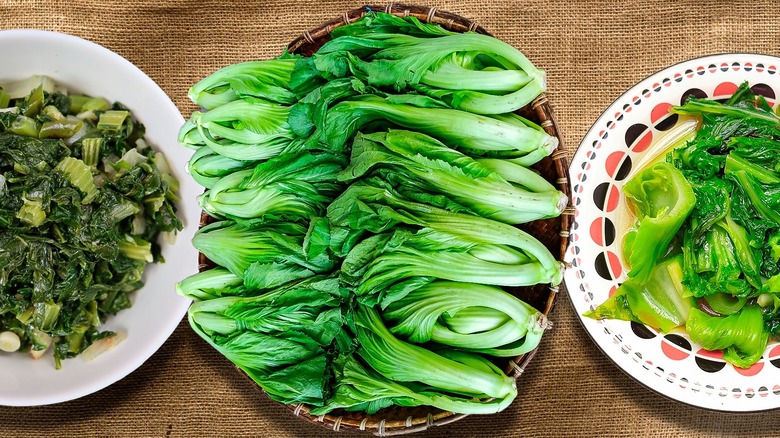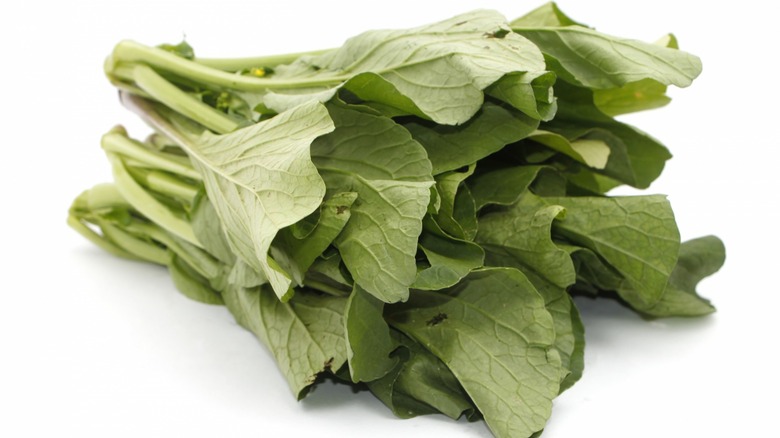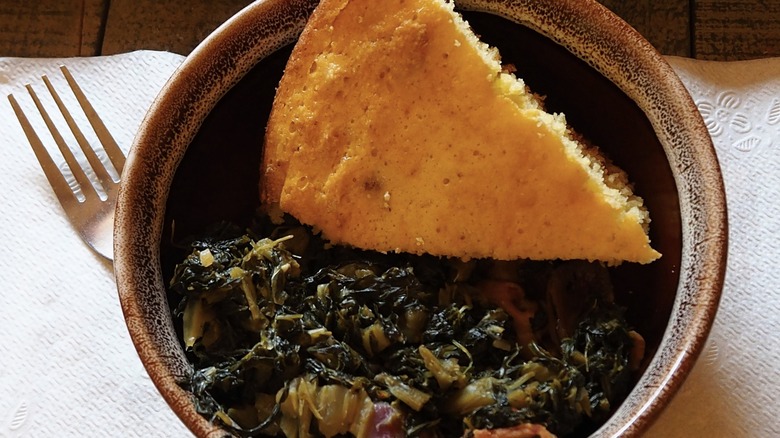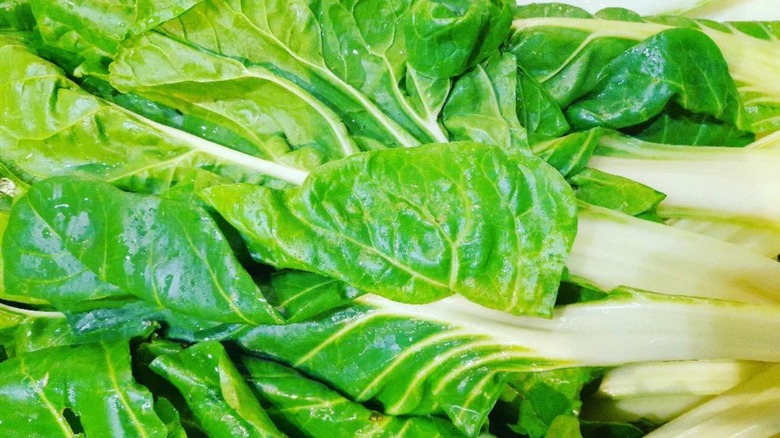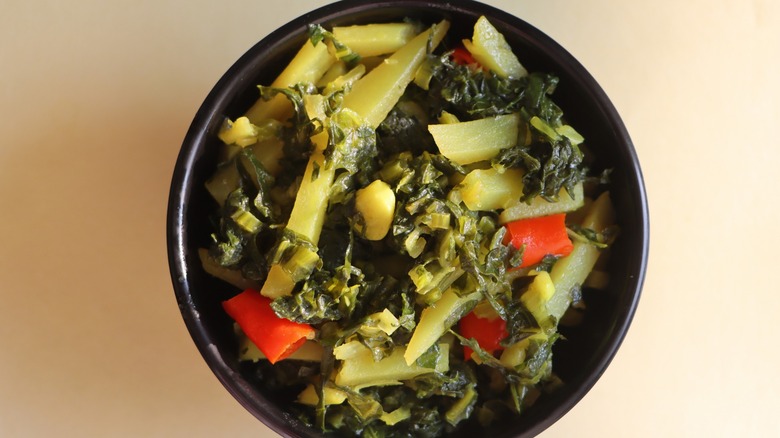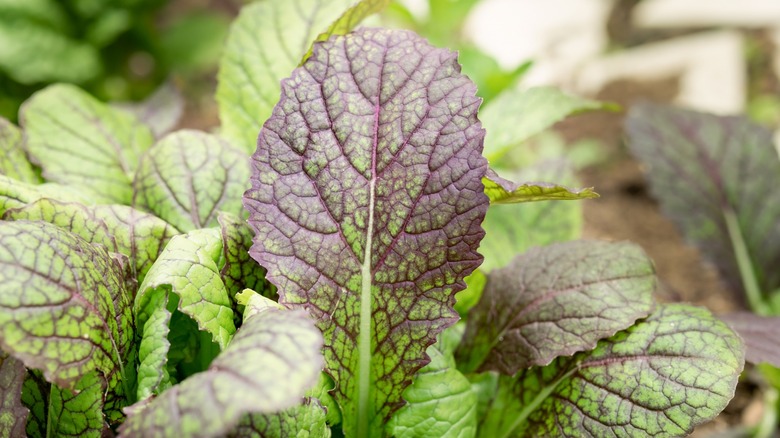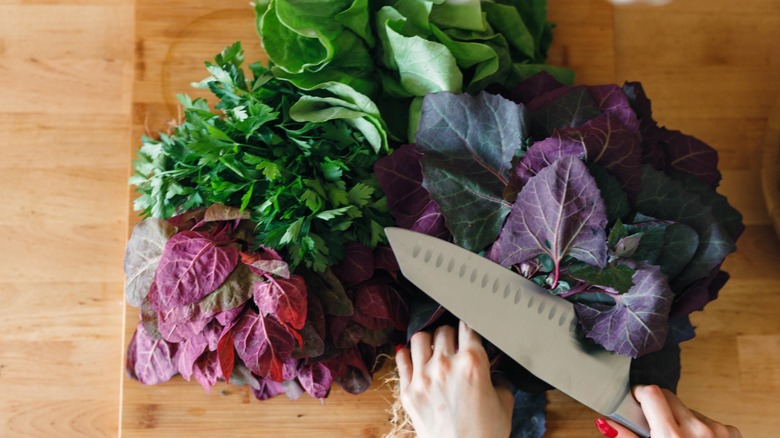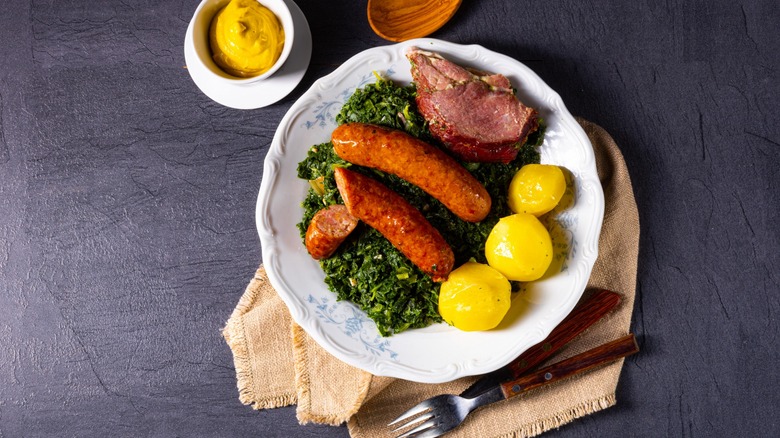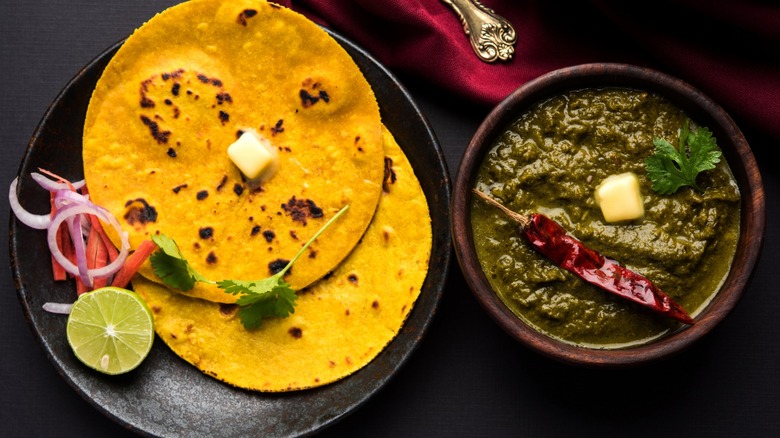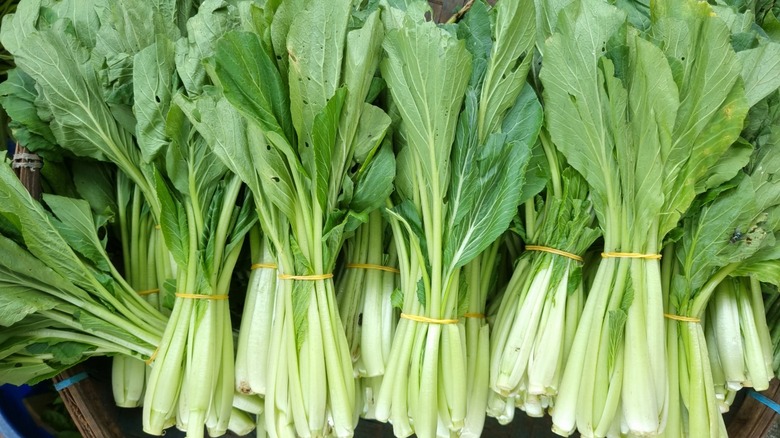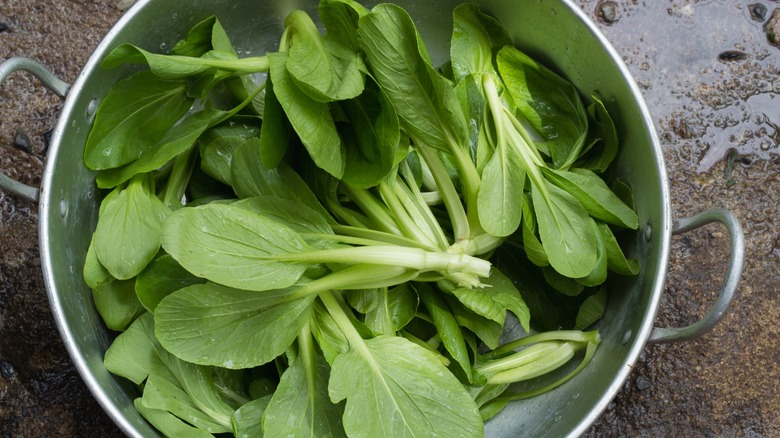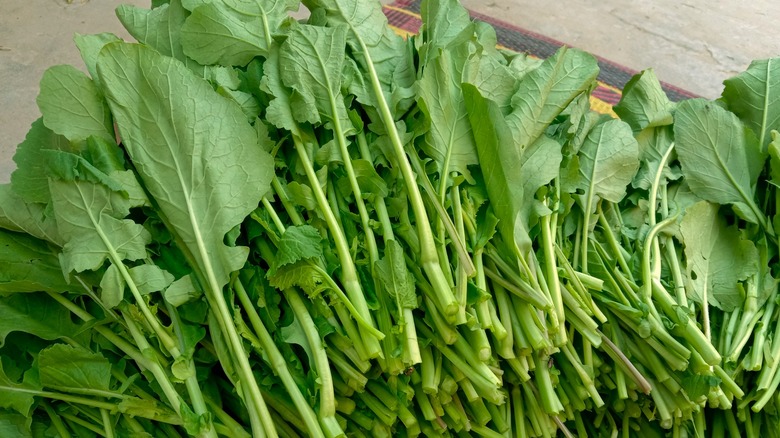Step Aside Kale, It's Time To Start Embracing Mustard Greens Instead
For the last few years, kale has enjoyed popularity as "the" super green for health and wellness. It appeared everywhere on salads, shakes, and even gourmet dinners. But if you're bored of kale, never fear. There is another option that is also part of the bitter green family and just as healthy. It's time to embrace the tangy goodness of mustard greens.
Historically, mustard greens have been used as an antiseptic herb for treating injuries. So why is Tasting Table writing about a green that's been used to heal wounds? Because this green also has a long and rich history as a culinary herb from China to Europe and from India to the Deep South. While it packs as much nutritional value as kale, its complexity, unique flavor, and versatility make it far more interesting.
There are several varieties available. And that means that these greens suit many different dishes and cooking styles, from the most basic salad to a creative soul food recipe. You can even add them to a green smoothie if you're looking for a little spice in your drink. Mustard greens are the perfect replacement for kale in modern cooking.
What are mustard greens?
Popular in Asian, Indian, and African cuisine, this leafy vegetable is a type of bitter green. Mustard greens are part of a genus of plants known as Brassica, which includes other bitter greens, like kale and collard, as well as broccoli and cauliflower.
There are over nine varieties of mustard greens available. Japanese Giant Red has been compared to horseradish and garlic. Golden Frill is a sweeter variety that can sometimes produce a root that is also edible. And tatsoi, frequently used in Chinese cooking, tastes a little like bok choy. Each variety has its distinctive flavor, providing endless possibilities in the kitchen. However, all varieties do have one thing in common: their spiciness. Some are pungent, while others are mild. We recommend sampling different ones to see which suits your recipes the best.
Mustard greens are often confused with collard greens, but their flavor has more punch and bitterness. Cooking can reduce the spiciness of bitter greens, but the underlying flavor will always have a hint of mustard. That's because they are all grown from mustard seeds, the essential ingredient for all types of mustard. Mustard greens are surprisingly flexible. You can eat them raw and give your salad an extra kick, or cook them up. They are a great way to add a complex flavor to a warm dish that calls for greens.
The origin and history of mustard greens
The history of mustard seeds and plants dates back thousands of years. While native to India, mustard plants were first cultivated in China. However, Europeans also cultivated them centuries before spices were imported by Asia. Mustard was so highly valued there that many farms employed a specialist called a mustardarius to oversee crop supervision. The international appeal of mustard greens is understandable because these plants are so easy to grow.
Today, we are more familiar with cooked mustard greens as a typical ingredient for Southern cooking and soul food, although collard greens are more commonly known. Cooking bitter greens is a technique that was employed across the continent of Africa and brought to America by enslaved people. At the time, greens and other abundant vegetables were usually cooked in pork fat. This added flavor and nutrition, but it also stretched meals for hungry mouths and added flavor. The leftover juices were called pot likker (meaning liquor). People dipped cornbread in the juice, a practice reminiscent of African mealtime traditions. This all contributed to the birth of soul food and how mustard greens became a staple of Southern cuisine.
Nutrition facts for mustard greens
If you're looking to support your fitness routine, a vegan lifestyle, or have better health in general, you can't go wrong with mustard greens. This mighty herb is full of fiber and micronutrients for only 15 calories per cup of raw greens. It is rich in vitamins, including a good amount of vitamin C. Like many other greens, this veggie contains a high amount of vitamin K, which assists with blood clotting. For people on blood thinning medication, this can be dangerous, so limit your intake of greens or get your doctor's approval.
What makes mustard greens really stand out, besides their flavor, is that they contain several different antioxidants. These molecules fight oxidative stress, a condition that damages your cells, leading to disease and early aging.
Mustard greens contain essential antioxidants like vitamins C and E, which are necessary to live, and others that support good health. Each variety contains different antioxidants. Spicing up your meals with different varieties of mustard greens not only expands your culinary skills. It can help you boost your health. Better yet, they are a great replacement option if you are bored of kale.
Caution when cooking and eating mustard greens
As long as you are not on blood-thinning medication, mustard greens are safe to eat and cook in any way that you like. But thanks to anti-cancer compounds known as glucosinolates, these vegetables are incredibly bitter. Fortunately, you can reduce the bitterness without eliminating their spicy flavor.
The first approach is to balance them by seasoning them with a strong spice. You can do this by pairing mustard greens with red pepper flakes. You can also add spicy meats, such as hot sausage, to enhance the earthiness of the greens while reducing the bite.
You can also braise them, which is different from stewing. Braising is done by pan-searing large cuts of meat with small amounts of liquid. Juices are typically served separately from meat, similar to the pot likker process. Braising reduces bitterness and infuses more flavor into your mustard greens.
Another cooking process to try with this vegetable is blanching. Submerge greens in boiling water just before they are cooked, then dunk them in cold water briefly. Avoid the blanching mistake of leaving them in too long, or they will lose too much flavor.
Finally, you can use a very acidic vinaigrette to salads with mustard greens to reduce bitterness. If you're cooking your greens, finish the dish with a little vinegar. These techniques bring out the natural flavor of mustard greens, giving a delicious and complex dish with much less bitterness.
Growing mustard greens for yourself
If you are sold on adding mustard greens to your recipes, consider growing these plants for yourself. Your first step is to select the right variety in color and flavor. Each type has a slightly different time to maturity, but otherwise, the gardening process is similar.
These plants are easy to grow in a variety of environments. Make sure your soil is well-drained and fertile. Keep soil pH balanced between 6 and 7.5 and the temperatures between 50 and 75 F. Mustard greens do well in full sun, but some varieties are more flexible for partial shade. You'll need about an inch or two of water per week and a good fertilizer. Weeds can quickly get out of hand, so manage them well.
In warmer regions, mustard greens are best to plant in the fall. Otherwise, you can also plant in the spring. With ideal soil conditions, these should germinate within a week. In about three weeks, you'll see three or four leaves. Wait one week before transplanting. Mustard greens only take about a month to fully mature. You can harvest and replant seeds throughout most of the fall and also in the spring if that's an option for you.
Even in gardening, mustard greens are versatile. They are pretty enough to use for landscaping, especially if you are creating an edible garden. You can grow mustard microgreens indoors in the winter. And they also thrive in a hydroponic environment.
Mustard greens vs. kale and collard greens
Mustard greens are part of a large family of bitter greens and make an excellent replacement for kale. Both bright green vegetables hail from the same genus, and their plants take a similar amount of time to grow.
However, they have many differences. Kale is firmer, making it crunchier even after cooking. It has a bitter, earthy flavor, while mustard greens have a peppery or tangy taste. Their softer texture makes the greens a better choice for cooking, while kale is better suited for a raw salad.
Both are nutritious, but a side-by-side comparison shows that mustard greens have more fiber and vitamins B2, B3, and B5. Kale has more calories, but it also contains more potassium, vitamin C, calcium, iron, and vitamins B6, B3, and B9. Mix both of these into your diet to get the most nutritional value.
Mustard greens are also often confused with collard greens. Both come from the same genus. However, that's where the similarities end. Collard greens have no spiciness or tang and taste much more like standard salad greens. While they can get bitter over time, it's nothing compared to the pungency of mustard greens.
Collard greens are a milder choice and better suited for raw dishes. However, mustard greens beat the nutritional value of collard greens in just about every category. When subbing in a recipe, kale and mustard greens are closer in taste, while collard greens will change the entire flavor of the dish.
Cooking with mustard greens
You can use mustard greens for a variety of dishes. A basic mustard green salad with a strong vinaigrette is the first place to start. Create a dressing using ingredients like salt, olive oil, apple cider vinegar, Dijon mustard, and pepper. Add a dash of maple syrup to make your dressing more reminiscent of Creole mustard. You can also add green or other varieties of apples to help balance the tanginess.
Mustard greens are an excellent option for cooking, which will help sweeten this vegetable. A simple dish like sautéed mustard greens works well when you add details like pungent onions. Remember that spicy accompaniments reduce the bitterness of the greens even more, so you're likely to see many recipes incorporating sausage, especially hot varieties, ham, and bacon.
With a background in both Asian and African cuisine, mustard greens help turn up the heat and variety on a lot of everyday recipes. For example, you can add them to your next stir-fry recipe. Add flair to mundane Asian rice dishes by making Fried Rice With Pickled Carrots And Mustard Greens. This dish provides a healthy serving of nutrition with a bang since it also contains peppercorn and Sriracha. Can you feel the fire now?
Best recipes for mustard greens
Mustard greens are ideally suited for Southern recipes and soul food dishes. However, you can also get creative with other dishes too. Use mustard greens in a variety of dishes beyond salads and sautées. For example, they go great in stews, especially in milder recipes such as white bean stew.
For a more Asian-influenced flavor, cook them with fragrant spices. Sambal matah is a mouth-watering seasoning made with lemongrass, makrut lime leaves and juice, coconut oil, and soy sauce that goes well atop steamed mustard greens.
There are so many great recipes that you can serve to complement mustard greens. Several soul food options work wonderfully, such as jalapeño cheddar cornbread with a side of braised mustard greens. Use the bread to soak up the pot likker. Southern mac and cheese, made with béchamel, is so creamy and mildly delicious that it pairs well with a mustard greens side salad. For a decadent Southern dinner that will keep your guests coming back for more, serve a crawfish étouffée and black-eyed peas with sautéed mustard greens. No one will have room for dessert!
Storing and preserving mustard greens
While mustard greens have hardy leaves, take some precautions when freezing greens to ensure long life without reducing the flavor or wilting. When you get them home, wash them well and thoroughly dry the leaves if you are not using them immediately. Damp leaves will wilt and spoil faster than dry ones. Be careful not to bruise them.
If you are storing them for a few days, keep the greens in an airtight container or bag in your fridge. If you have grown your own, you'll want to store them for a longer period. In that case, use ventilated storage containers, like produce drawers. The greens will keep for up to two weeks.
Some cooks say you should never freeze greens. However, if you want to do this, you can blanch the greens before freezing them. Place them in boiling water for a few minutes, then add them to ice water. This process helps them stay fresh longer without fully cooking them. You can keep blanched greens in your freezer for eight to 12 months.
If you don't want to blanch them, you may be able to freeze them anyway. You may be putting the vegetable at risk of wilting, spoiling, or changing taste and texture, but it can be done. Spread them on a baking sheet and put them in the freezer for two or three hours. Then, seal them in an airtight bag to freeze. They should remain usable for nine months.
How to buy mustard greens and seasonality
Mustard greens are sold in bunches in the produce section at your grocery store. When selecting, look for bright green and colorful leaves that are strong and fresh. Avoid any with holes, wilting, or other types of damage. Wilted greens will not have as much flavor or nutritional value and will not last as long. Be sure to buy them in season for the best choices. Availability may depend on the variety.
They are in season during spring and fall, although warmer regions will be more likely to have mustard greens in stock in the fall. You likely will not find them packaged or canned unless you are in a specialty ethnic store, such as an Asian grocer. These stores may carry canned, pickled, or fermented mustard greens.
Mustard greens are often raised with pesticides that can be very difficult to wash off. If you can, buy organic. If not, use a high-quality, natural veggie wash to ensure your produce is as residue-free as possible.
Where to buy mustard greens
If you're looking for fresh mustard greens for eating and cooking, you can find them in season at some major grocery stores in the produce aisle. You may also be able to find them at your local farmer's markets. A single bunch of mustard greens are available at Walmart for $1.48.
Canned mustard greens are more difficult to find except in certain regions. However, you can buy seasoned Southern-style mustard Greens by Glory Foods at Walmart for $3.90.
You can find mustard seeds or plants for gardening online. Purchase green mustard microgreen seeds at Amazon for $20.49 per one-pound bag. You can also find USDA-certified organic standard-sized mustard seeds online. Purchase an assorted 4-pack at Amazon for $9.97 or purchase individual packs of different varieties at Johnny's Selected Seeds. You can also buy mustard green plants at Home Depot for $5.98 for six units when they are in season, fall or spring.
